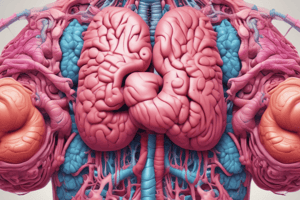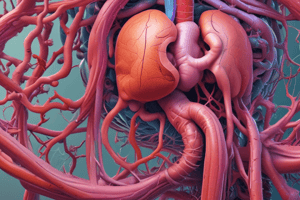Podcast
Questions and Answers
A tissue is defined as a group of diverse cells with varying structures working together to perform multiple functions.
A tissue is defined as a group of diverse cells with varying structures working together to perform multiple functions.
False (B)
Organ systems are formed when similar tissues combine to perform a coordinated function.
Organ systems are formed when similar tissues combine to perform a coordinated function.
False (B)
The digestive system relies on both the stomach and glands to chemically process food.
The digestive system relies on both the stomach and glands to chemically process food.
True (A)
The primary role of the small intestine involves enzymatic digestion of lipids.
The primary role of the small intestine involves enzymatic digestion of lipids.
Bile, produced by the gallbladder, directly breaks down lipids into fatty acids and glycerol.
Bile, produced by the gallbladder, directly breaks down lipids into fatty acids and glycerol.
The large intestine primarily functions to enzymatically digest remaining nutrients before elimination.
The large intestine primarily functions to enzymatically digest remaining nutrients before elimination.
Enzymes function by permanently altering their structure after a reaction, thus being consumed in the process.
Enzymes function by permanently altering their structure after a reaction, thus being consumed in the process.
Enzymes maintain their peak activity even when the temperature significantly exceeds their optimum, experiencing only a gradual decline in efficiency.
Enzymes maintain their peak activity even when the temperature significantly exceeds their optimum, experiencing only a gradual decline in efficiency.
All enzymes function best at a neutral pH of 7, ensuring optimal catalytic activity regardless of their origin or function within the body.
All enzymes function best at a neutral pH of 7, ensuring optimal catalytic activity regardless of their origin or function within the body.
According to the lock and key hypothesis, an enzyme's active site remains flexible to accommodate a range of substrates.
According to the lock and key hypothesis, an enzyme's active site remains flexible to accommodate a range of substrates.
An enzyme's denaturation is a reversible process, allowing it to regain its original shape and function once optimal conditions are restored.
An enzyme's denaturation is a reversible process, allowing it to regain its original shape and function once optimal conditions are restored.
Changes in pH affect enzyme activity by altering the active site's shape, preventing the substrate from binding correctly, and thereby disrupting the reaction.
Changes in pH affect enzyme activity by altering the active site's shape, preventing the substrate from binding correctly, and thereby disrupting the reaction.
A slight temperature increase above an enzyme's optimum will cause a minor reduction in its reaction rate, primarily due to increased molecular motion.
A slight temperature increase above an enzyme's optimum will cause a minor reduction in its reaction rate, primarily due to increased molecular motion.
Flashcards
What are cells?
What are cells?
Basic unit of life; the building blocks of living organisms.
What is a tissue?
What is a tissue?
A group of similar cells performing a specific function.
What is an organ?
What is an organ?
Structure made of different tissues working together.
What is an organ system?
What is an organ system?
Signup and view all the flashcards
What is the digestive system?
What is the digestive system?
Signup and view all the flashcards
What are enzymes?
What are enzymes?
Signup and view all the flashcards
What is the active site?
What is the active site?
Signup and view all the flashcards
What is the Lock and Key Hypothesis?
What is the Lock and Key Hypothesis?
Signup and view all the flashcards
Optimum Temperature
Optimum Temperature
Signup and view all the flashcards
Enzyme Denaturation
Enzyme Denaturation
Signup and view all the flashcards
Temperature and Reaction Rate
Temperature and Reaction Rate
Signup and view all the flashcards
Optimum pH
Optimum pH
Signup and view all the flashcards
pH's Effect on Enzymes
pH's Effect on Enzymes
Signup and view all the flashcards
Study Notes
- Cells form all living organisms.
- Tissues consist of specialized cells that share similar structure and function, and may include multiple cell types.
- Organs are composed of various tissues working in coordination to perform specific functions.
- Organ systems are groups of organs that collaborate to carry out particular bodily functions.
Animal Tissues, Organs, and Organ Systems
- Digestive system is an organ system where organs collaborate to perform a certain function.
- Food consists of large, insoluble molecules that must be broken down for absorption by cells.
The Human Digestive System
- Key digestive system organs:
- Glands (salivary glands and pancreas): Produce digestive juices with enzymes to break down food.
- Stomach: Produces hydrochloric acid to kill bacteria and provide the optimal pH for protease enzyme function.
- Small intestine: Soluble molecules are absorbed into the bloodstream.
- Liver: Produces bile, stored in the gall bladder, to aid in lipid digestion.
- Large intestine: Absorbs water from undigested food, forming faeces.
- Rectum and anus: Eliminate faeces from the body.
Enzymes
- Enzymes are biological catalysts that speed up reactions without being consumed.
- Enzymes control numerous reactions.
- Enzymes can break down large molecules and combine small ones.
- Enzymes are proteins, and their shape is crucial for their function.
- Each enzyme has a unique active site where the substrate binds.
Lock and Key Hypothesis
- The substrate's shape is complementary to the active site's shape, forming an enzyme-substrate complex upon binding.
- Once bound, the reaction occurs, and products are released from the enzyme's surface.
Enzyme Conditions
- Enzymes require optimal pH and temperature to function effectively.
- Optimal temperature: Around 37°C (body temperature).
- Reaction rate increases with temperature up to the optimum; beyond it, the rate declines rapidly until the reaction stops.
- Excessive heat breaks the bonds in the enzyme's structure, altering the active site shape.
- Denaturation: The enzyme's shape is changed, preventing substrate binding.
- Optimal pH: Typically 7, but some enzymes, like those in the stomach, function best at low pH levels.
- Too high or low pH affects the amino acid chains in the protein.
- Denaturation: The enzyme's shape is altered, preventing substrate binding.
Studying That Suits You
Use AI to generate personalized quizzes and flashcards to suit your learning preferences.
Description
Explore the organization of life, from cells to organ systems, with a focus on the human digestive system. Learn about the key organs involved in digestion, including the stomach, small intestine, and liver, and their roles in breaking down food for absorption.




